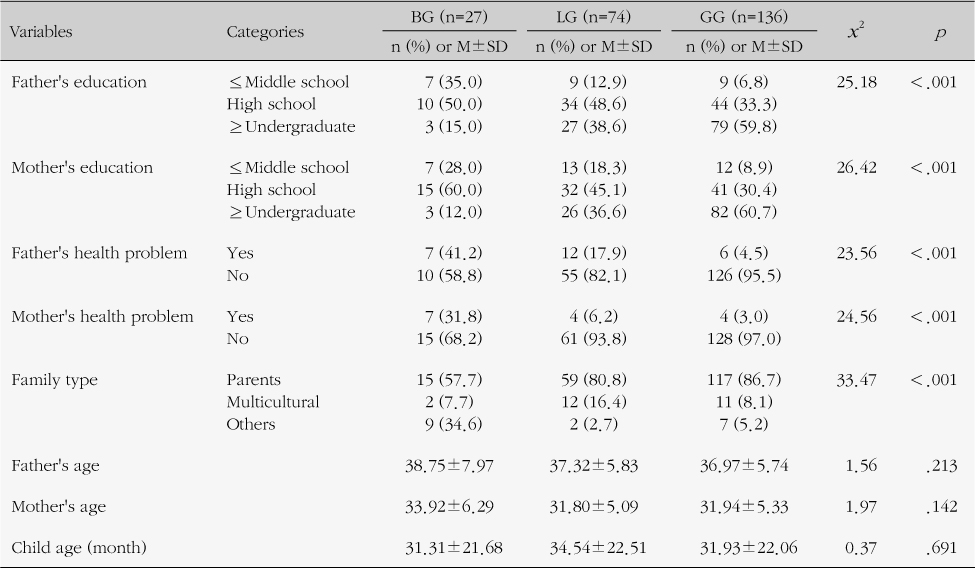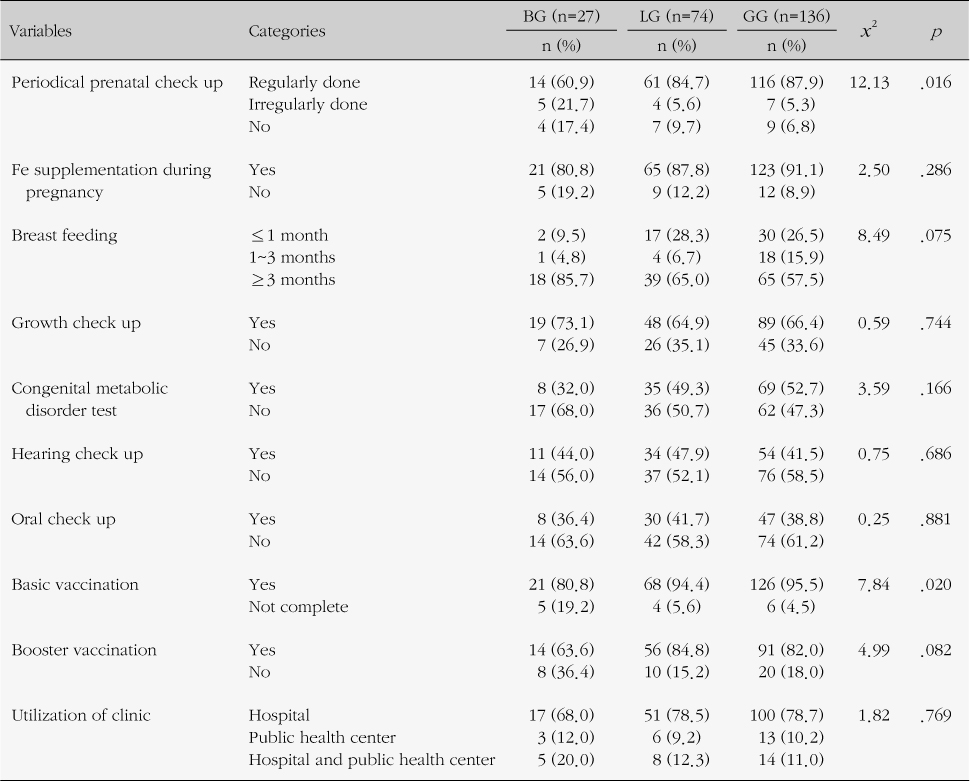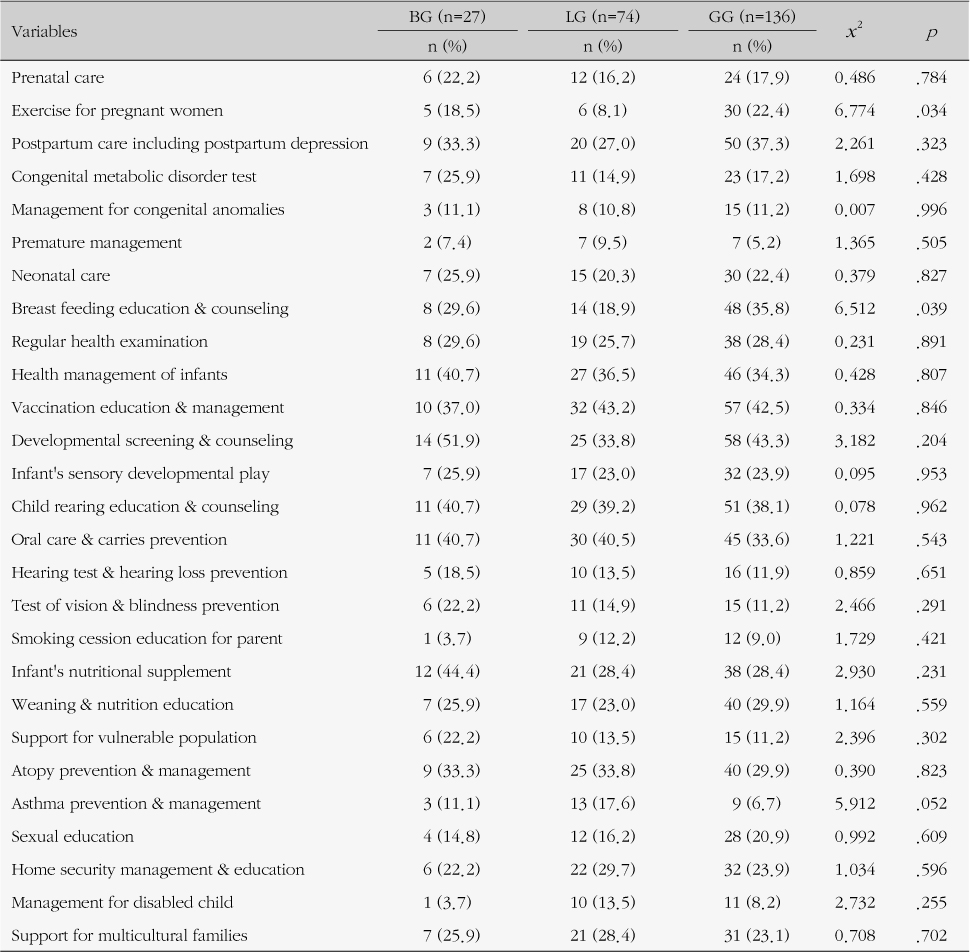References
1. Bang K. Comparison of Maternal Health Related Characteristics, Child Rearing Burden, and Social Support in Mothers of Preschoolers: According to Socioeconomic Status. J Korean Acad Child Health Nurs 2007;13:390–398.
2. Bang KS, Yoo HR. Health care management status of pre-schoolers depending on the children's characteristics. J Korean Community Nurs 2004;15:84–94.
3. Bang KS, Yang S, Hyun HJ, Kim JS. Health and child rearing status of infants and preschool children in poverty -For the we start program in Kyunggi province-. J Korean Soc Matern Child Health 2008;12:104–115.
4. Choi YH. Factors influencing on the change among case management with hypertension patients in fitting home visiting health service center. J Kyungpook Nurs Sci 2010;14(2):33–46.
5. Choi YK, Kim KY, Lee MS, Na BJ, Kim EY, Shim YB, et al. Timeliness of infant immunization rate at public health centers. J Korean Soc Matern Child Health 2008;12:181–198.
6. Dennis CL, McQueen K. The relationship between infant-feeding outcomes and postpartum depression: A qualitative systematic review. Pediatrics 2009;123:e736–e751.
7. Eun BL, Kim SW, Kim YK, Kim JW, Moon JS, Park SK, et al. Introduction of national health screening program for infant and children. J Korean Child Neurol Soc 2007;15:142–147.
8. Ju TJ, Park HW, Ma DS, Seo HW. Survey of dentists on infant oral health care in Seoul, Gyeonggi-do, Gangwon-do, Korea. J Korean Acad Oral Health 2010;34:117–125.
9. Kim HJ, Yoo JS, Kim HS, Tak YJ. Report on tailored home visiting nursing service for children in Chungcheongbook-do Chungju: Chungju University; 2009.
10. Kim MW, Yang HS, Kim JR. A study on agreements among screening tests and related factors with postpartum depression. Korean J Obstet Gynecol 2009;52:1133–1143.
11. King WJ, LeBlanc JC, Barrowman NJ, Klassen TP, Bernard-Bonnin AC, Robitaille Y, et al. Long term effects of a home visit to prevent childhood injury: Three year follow up a randomized trial. Inj Prev 2005;11:106–109.
12. Korea Center for Disease Control & Prevention. National health statistics in 2008 -Korean national health and nutrition survey- Seoul: Korea Center for Disease Control & Prevention; 2008.
13. Korea Consumer Agency. Study of children safety accidents at home Seoul: Korea Consumer Agency; 2010.
14. Kwon IS, Seo YM. Home nursing and quality of life in parents of children with atopic dermatitis. J Korean Acad Child Health Nurs 2009;15:401–408.
15. Lee JS. The significance of vision 2030 as a new paradigm. Health Welf Policy Forum 2006;121:41–49.
16. Lee SY. Developing the framework of the national health plan 2020 of Korea Seoul: Korea Institute for Health and Social Affairs; 2008.
17. Ministry of Health, Welfare and Family Affairs. Plans to Maternal Child Health for Maternal and Infants Health Improvement Seoul: Ministry of Health, Welfare and Family Affairs; 2009.
18. Ministry of Health and Welfare. Studies on the level of health concern each city and province Seoul: Ministry of Health and Welfare; 2010-a.
19. Ministry of Health and Welfare. Korean National Oral Health Survey 2010 Seoul: Ministry of Health and Welfare; 2010-b.
20. Ministry of Health and Welfare. Basic livelihood security Seoul: Ministry of Health and Welfare; 2011.
21. National Health Insurance Corporation. Analysis of the result of health examination in 2007 Seoul: National Health Insurance Corporation; 2007.
22. Park JS, Hong YS. Development of linkage model of registry & management service for high risk group of coronary & cerebral vessel disease and tailored home visiting health service. Keimyung J Nurs Sci 2010;14(1):63–74.
23. Park OJ, Lee MJ, Kim JH, Min SH, Lee HS. The Effect of Nutrition Plus Program among 0~5 Year Children in the Yeojoo Area: The Improvement in Nutritional Status of Children after Nutrition Supplement of Children and Nutrition Education in Parents/Guardians. Korean J Community Nutr 2009;14:767–776.
24. Pierce KM, Rozier RG, Vann WF. Accuracy of pediatric primary care providers' screening and referral for early childhood caries. Pediatrics 2002;109:E82–94.
25. Rha YH, Choi SH. Risk factors associated with development of atopic dermatitis. Pediatr Allergy Respir Dis 2009;19:91–94.
26. Ryu AL, Kim TH, Lee HH. Evaluation of risk factors for the postpartum depression with Edinburgh Postnatal Depression Scale (EPDS) Score. Korean J Perinatol 2010;21:74–80.
27. Song HJ. Accident and injury in childhood and policy implications in Korea. Health Welf Policy Forum 2006;116:89–98.
28. Statistics Korea. The statistics of marriage in 2010 Seoul: Statistics Korea; 2011.
29. Turyk M, Curtis L, Scheff P, Contraras A, Coover L, Hernandez E, et al. Environmental allergens and asthma morbidity in low-income children. J Asthma 2006;43:453–457.
30. Yum CH. Comparison, analysis, and its implications between the Head start programs in the United States and we start programs in Korea. Korean Comp Educ Study 2008;18(2):47–67.




